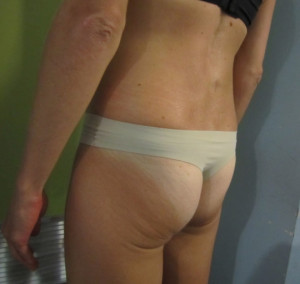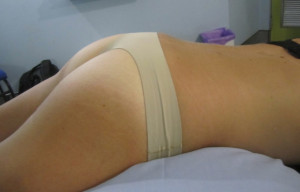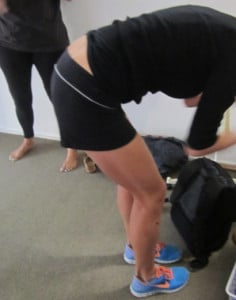‘Strengthening the glutes’ is considered an important element in many therapeutic and fitness exercise programmes. The rationale may be that they are weak; ‘not firing properly’ or simply that they do not have a good shape. Strong glutes are deemed to be the powerhouse for action. The hunt for ‘the best glute exercises’ is evident.
I see many people who have been ‘working on their glutes’ yet end up in my clinic with a variable array of symptoms that can be linked to poor exercise prescription and faulty patterns of control. Symptoms vary but can include: – tight buttocks and hamstrings and ‘always needing to stretch’; sciatica; hamstring tears; hip pain; groin pain; knee pain; shin splints; plantar fasciitis; achilles tendinopathy and so on.
What’s the link to the glutes?

One of the defining characteristics of man is the gluteus maximus which enabled us to be erect against gravity and to raise and lower ourselves from and to the ground. Important as the glutei certainly are in pelvic-hip control – they don’t work alone.
Healthy kinematic patterns of lumbo-pelvic-hip control depend upon the balanced co-activation of many muscles to support and control the spino-pelvis on the femoral heads. This involves 3D control of force couples as the pelvis tilts shifts and rotates in the three cardinal planes of movement – sagittal, coronal and frontal plane.
To effectively do this, we need to control intrapelvic myomechanics, spatial shift of the pelvis and closed and open chain hip movements.
All of these interdependent functions rely a lot on upon inner support and control from a myo-fascial collective which I have called the ‘Lower Pelvic Unit’ which modulates important basic patterns of lumbo-pelvic control (diaphragm, transversus abdominis, multifidus, iliacus, psoas, pelvic floor and the deep hip rotators).
These Lower Pelvic Unit synergies also provide pelvic stability and internal counter-support against the potentially ‘yanking’ actions of the ‘outer muscles’ – the glutei and the superficial long leg muscles attaching to the pelvis – in particular the hamstrings, quads, adductors and tensor fascia lata.
The ‘inner control’ needs to have the capacity to match the ‘outer control’ for healthy patterns of movement. Otherwise the lumbo-pelvis becomes adversely ‘stressed’ in daily functional activities setting up the stage for various local and referred pains.

Let us just consider basic functional control of the pelvis in the sagittal plane – the ability to sit, stand, bend, squat and walk.
Fundamental to all these actions is control of what I have termed The First Fundamental Pelvic Pattern (FPP1). This is basic to being able to control a lumbo-pelvic ‘neutral’ position while moving the hips into flexion and extension – both open and closed chain.
The common problem: basic sagittal plane control
Commonly, people presenting with lumbo-pelvic pain disorders can’t control the FPP1. They compensate for this deficient Lower Pelvic Unit control with augmented superficial muscle activity with dominant synergistic activation in the glute max, hamstrings, the deep external hip rotators including piriformis and probably the posterior pelvic floor. Many patients habitually ‘butt clench’ when antigravity. Most find it easy to do so and will attempt to control the pelvis through this dominant synergy. They are good at activating these muscles in their inner range!.
What they find difficult is letting them go! – being able to eccentrically lengthen them to allow opening of the posterior hip – involving posterior pelvic shift, anterior pelvic rotation and closed chain hip flexion with control of the low lumbar lordosis.
When standing, poor FPP1 control and the associated relatively unopposed ‘outer’ synergies of myo-fascial hyperactivity result in the pelvis being ‘held’ in posterior tilt and innominate outflare with associated lumbosacral flexion in posturo-movement. This leads in time to the joints becoming stiff in these positions, further disturbing the ability to modulate intrapelvic myomechanics. Control of all the Fundamental Pelvic Patterns suffers – in particular FPP1 which is the basic building block in healthy sagittal control. Tightness in the whole posterior myofascial system from the pelvis to the toes becomes apparent further limiting ‘hinging’ forward at the hips – the spine is forced to further compensate

FPP1 involves anterior innominate rotation and ‘inflare’, ischial ‘outflare’ and sacral nutation and associated control of the lumbar lordosis. This ability to drive the ischia back and wide and bring the tail bone back is necessary in order to sit down and stand up from sitting, ‘sit up straight’, bend over or squat as well as move at the hips. Poor control of the Fundamental Pelvic Patterns is variably evident in all those with lumbopelvic pain and related pain syndromes. Intrapelvic torsions are also common.
How to better exercise the glutes to promote healthy function?
Establish control of FPP1! This enables the client to bring both his pelvis and lumbar spine into the ‘neutral’ position and as capacity and endurance build, he is able maintain this through movement – including ‘strengthening the glutes’. Without this ‘inner’ co-activation, ‘glute exercises’ risk jeopardising the health of the spine and pelvis.
A diverse array of ‘injuries’ will be likely sooner or later. It is generally not well appreciated that the genesis of these injuries is defective lumbopelvic control.
FPP1 needs to first be established antigravity with the ability to sustain it with limb load challenge. Then the client is asked to use it more in gravity loaded postures – sitting and kneeling etc.
As capacity and endurance in the FPP1 improve the glutes can be increasingly worked in more ‘loaded postures’ and through range – outer being particularly important – sit to stand, squat, forward bends, lunge, single leg deadlifts and so on.
However if the challenge is beyond the client’s abilities to control FPP1, he will go into ‘superficial lock down’ which just reinforces abnormal synergies of control.
This is common and a real driver of many symptoms.
Quality control in healthy functional kinematic patterns should be the goal where the glutes learn to be team players with the Lower Pelvic Unit triplanar synergies of control.
Leave a Reply